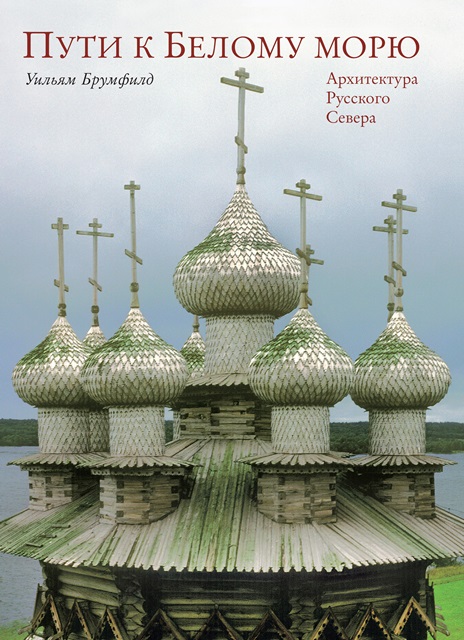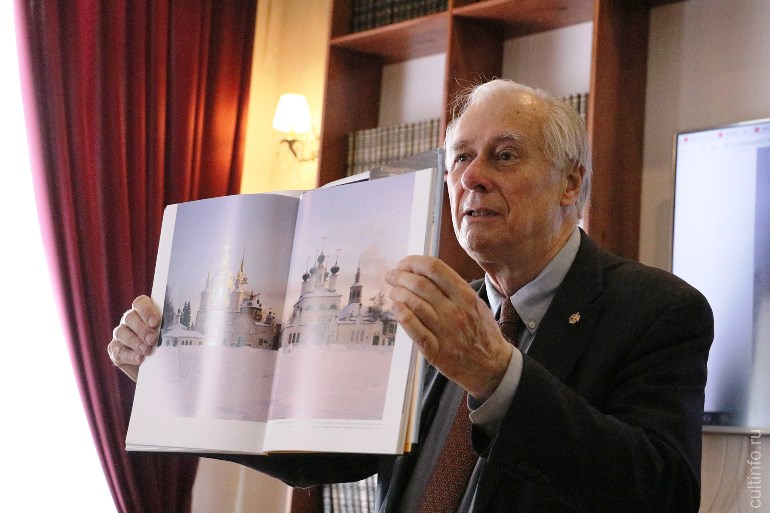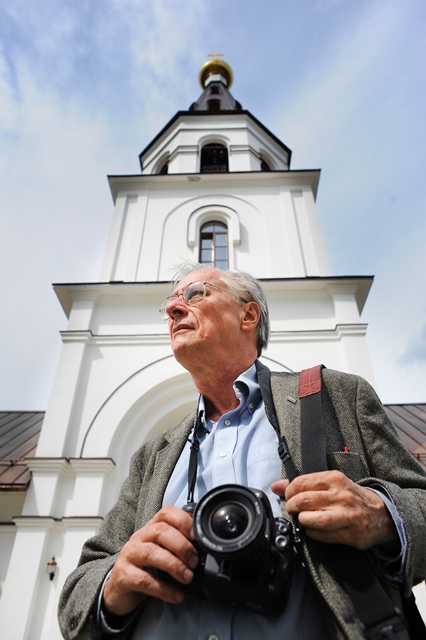
Heading to the Russian North for freedom
/ Главная / Russkiy Mir Foundation / Publications / Heading to the Russian North for freedomHeading to the Russian North for freedom
William Brumfield, a researcher of Russian architecture and Professor of the Tulane University (New Orleans), has travelled thousands of kilometers along passable and impassable roads of the Russian North. Architecture at the End of the Earth, his book published in the USA in 2015, became quite an event in the scientific community. Russian edition of Towards the White Sea has been published this year.
While working on the book, the scientist was able to show his worth not only as an architecture researcher and photo artist, but also as an ethnographer and adventure writer to some extent. The American told the Russkiy Mir about people of the Russian North and the footage he had made, about snowstorms and the world of genuine freedom, which opened to him in places which used to be an exile destination in Tsar’s times.
Driving the UAZ in search for treasures
– When you were writing essays for the book about the Russian North, what was important for you to tell American readers?
– I wanted to convey beauty of those places and benevolence of their inhabitants, but also to tell about difficulties of working there. This is a huge area with impassable roads and harsh climate. I am very grateful to my Russian colleagues from Moscow and northern cities for their help in the work. I was always welcomed and helped - by scientists, local officials, and priests. I sought assistance in towns of district status, and they gave a car there, mainly an UAZ with a driver, and we set off on a journey around local villages.

The book cover. Photo courtesy of William Brumfield
– You say that the Russian North is a unique region. To what extent does such uniqueness relate to climate and geographical location? Can you see anything similar in the north of Western Europe or in Alaska?
– There is something close, but the Russian North has a completely different environment. Unfortunately, the wooden architecture, which I was particularly interested in, is vanishing. But it represents a unique phenomenon. For example, ancient wooden temples have survived in Norway, but architecture of churches and residential buildings in Russia is totally different. By the way, I did not include museum objects in the book about the Russian North as a matter of principle. The publication includes pictures, including winter ones, of those buildings that are located in a natural environment. I wanted readers to experience the center of a unique ancient culture through such pictures of nature and wooden architecture.
– There is a picture of you at the back cover of the Russian edition. You stand in front of a log hut with overgrown burdocks. Does it symbolize in some way desolation of the northern monuments?
- Yes, to some extent. The log hut on the cover is boarded up; no one lives in it, that's why burdocks are overgrown. But it is absolutely amazing and has a rather distinctive roof. I saw it in the Krasnoborsky district of the Arkhangelsk Region, so we stopped and took a picture. Unfortunately, many log huts are abandoned. And those inhabited have been coated and reconstructed - living in such a house is probably more convenient, but the traditional look is distorted.
Authentic culture and ancestral memory
– In your opinion, are people in the Russian North different from residents of other regions of Russia? You have traveled all over the country, haven’t you?
– Of course they are different. People of the North have their own dialect, their own traditions, and their own distinguishing features. Yes, there are a lot of newcomers, and many indigenous people have left. But even today, you can experience authentic culture which originated from a medley of the Slavs and Finno-Ugric tribes. And nature also makes certain impact - huge forests, swamps, sea. It was important for me to understand distinguishing features of the Russian North and its inhabitants, and I discussed those topics with historians, art experts, and artists.
–– In Russia, it is believed that the inhabitants of the North are reserved and uncommunicative people.
– I didn’t notice that. They are open, friendly, and very benevolent people. I confess, I have often been at home feasts in the Russian North and have observed the whole spectrum of the Russian soul. But I understand perfectly well that life there is harsh. Perhaps that is the cause of some self-containment that you are talking about. I was also impressed by how they treasure and preserve the memory of the Great Patriotic War. For example, photographs of those who fought and died during the war can be seen in many local councils. Such devotion to memory of their ancestors strikes the mind.
– Do residents of villages with old wooden churches understand that such churches are treasure and legacy?
– They do, but in different ways. Churches in remote villages are closed because there are no priests, and people have a weary impression from that. I recall my first trip to Kargopol in the winter of 1998. There was a snowstorm, and I was standing admiring the wooden church. It was like a fairy tale. People were passing by, and we started talking. I was told: “You are taking pictures of churches, but you have no idea how hard our lives are.” And they were absolutely right. Life there, indeed, is not easy. But they managed to preserve local history museums and libraries in the most difficult times, which contribute a lot in preserving things that survived. And it is essential, and not only for residents of those places. Strange as it may seem, the ancient culture of the Russian North reveals us a world of genuine freedom despite the fact that the North used to be a place of exile for great number of people.

Photo credit: cultinfo.ru
– Your book in English and Russian will, for sure, encourage some visitors to come to the Russian North. Does this region need tourism?
– Of course! I believe that it is necessary to aim for development of tourism. And in some places it is developing, the infrastructure is improving. For example, small hotels have opened in Kargopol, and current situation in this respect is much better there than 20 years ago. Development of tourism depends on the roads to a great extent. And there are positive examples. For example, the Kirillovsky district of the Vologda Region, where there was a turn for the better. I hope my work helps to draw people's interest to these regions. But, I’d like to note, you need to be careful with tourism. Sometimes tourist flow distorts the local culture, and residents begin to make themselves over to please tourists.
– It appears from your photographs that there is no “off season” for you. However, the North is the North. Has the weather ever interfered with your plans in the Russian North?
– Never. It has been the other way around. Sometimes extreme conditions bring better results. I was able to shoot amazing winter landscapes at the time of frost and snowstorm.
Russian culture in disfavour
– The American edition was published four years ago. It was highly welcomed by Russian mass media. And how did American media react to it?
– The American media hardly wrote anything about the book. There were very good reviews in scientific journals, and in general the book was a success, but major newspapers did not react to the publication in any way. I remember, when History of Russian Architecture, my fundamental book, was released in the USA in 1993, it got a huge review in The New York Times. The book on the Russian North reflects a limited field, but still... The prestigious university publishing house that released the book sent dozens of copies to major mass media, and, again, there was no reaction. I suspect the New York Times would not publish such a review of that kind of book today. Why? Because Russian culture is in disfavor in the USA, if I can use such a word.
The book begins with the Murmansk Region and Karelia. The second chapter is mainly dedicated to Vologda Region. Then we move along the Onega and Dvina rivers to Mezen. This book describes my semicircle journey around the White Sea. Photos are published with the date of shooting. It is necessary to monitor the condition of monuments; unfortunately some of them do not exist anymore. We added information about losses in recent years to the Russian edition. Plus we included newer photos, and there were some technical changes.

Photo by Alexander Korkka
– After four years that have passed since the publication of the American edition of the book on the Russian North, do you feel any changes regarding Russian culture in the United States?
– I do not notice any turn for the better. Probably improvements can be found in such fields as music, dance, and so on. But there is a lot of controversy as well. A poisonous atmosphere reigns in number of American media in respect of some major cultural figures of Russia, for example, Valery Gergiev. However, some things are not that gloomy: there is an interest to my work in the USA - my university in New Orleans supports my work, there are sponsors and buyers of my books.
– You said the American edition had been a success. What did the experts and readers say?
– Yes, there has been a success. The book has been bought. It is very nice that there are people who love and appreciate such work. The success was probably ignited by the powerful visual component of the book, since photographs in it are extremely important. American readers saw something comprehensible, yet unknown to them. Those who got acquainted with the book called it a valuable research and thanked me for help to preserve knowledge and bring it to people in other countries. One reviewer, an expert in history of the Middle Ages, called my book “a letter of love for the Russian North” and said that my photographs were of great artistic, scientific and historical value.
New publications

 Mikhail Kalatozov, a director who transformed the world of cinematography in many ways, was born 120 years ago. He was a Soviet film official and a propagandist. Above all, he was capable of producing movies that struck viewers with their power and poetic language.
Mikhail Kalatozov, a director who transformed the world of cinematography in many ways, was born 120 years ago. He was a Soviet film official and a propagandist. Above all, he was capable of producing movies that struck viewers with their power and poetic language.  Ukrainian authorities have launched a persecution campaign against the canonical Ukrainian Orthodox Church (UOC), the biggest one in the country's modern history. Over the past year, state sanctions were imposed on clergy representatives, searches were conducted in churches, clergymen were arrested, criminal cases were initiated, the activity of the UOC was banned in various regions of the country, and monasteries and churches were seized.
Ukrainian authorities have launched a persecution campaign against the canonical Ukrainian Orthodox Church (UOC), the biggest one in the country's modern history. Over the past year, state sanctions were imposed on clergy representatives, searches were conducted in churches, clergymen were arrested, criminal cases were initiated, the activity of the UOC was banned in various regions of the country, and monasteries and churches were seized.  When Nektary Kotlyaroff, a fourth-generation Russian Australian and founder of the Russian Orthodox Choir in Sydney, first visited Russia, the first person he spoke to was a cab driver at the airport. Having heard that Nektariy's ancestors left Russia more than 100 years ago, the driver was astonished, "How come you haven't forgotten the Russian language?" Nektary Kotlyaroff repeated his answer in an interview with the Russkiy Mir. His affinity to the Orthodox Church (many of his ancestors and relatives were priests) and the traditions of a large Russian family brought from Russia helped him to preserve the Russian language.
When Nektary Kotlyaroff, a fourth-generation Russian Australian and founder of the Russian Orthodox Choir in Sydney, first visited Russia, the first person he spoke to was a cab driver at the airport. Having heard that Nektariy's ancestors left Russia more than 100 years ago, the driver was astonished, "How come you haven't forgotten the Russian language?" Nektary Kotlyaroff repeated his answer in an interview with the Russkiy Mir. His affinity to the Orthodox Church (many of his ancestors and relatives were priests) and the traditions of a large Russian family brought from Russia helped him to preserve the Russian language.

 The leaders of the Friends of the Great Russia cultural association (Amici Della Grande Russia) in Italy believe that the Western policy of abolishing Russian culture in Europe has finally failed. Furthermore, it was doomed to failure from the beginning.
The leaders of the Friends of the Great Russia cultural association (Amici Della Grande Russia) in Italy believe that the Western policy of abolishing Russian culture in Europe has finally failed. Furthermore, it was doomed to failure from the beginning.  Name of Vladimir Nemirovich-Danchenko is inscribed in the history of Russian theater along with Konstantin Stanislavski, the other founding father of the Moscow Art Theater. Nevertheless, Mr. Nemirovich-Danchenko was a renowned writer, playwright, and theater teacher even before their famous meeting in the Slavic Bazaar restaurant. Furthermore, it was Mr. Nemirovich-Danchenko who came up with the idea of establishing a new "people's" theater believing that the theater could become a "department of public education."
Name of Vladimir Nemirovich-Danchenko is inscribed in the history of Russian theater along with Konstantin Stanislavski, the other founding father of the Moscow Art Theater. Nevertheless, Mr. Nemirovich-Danchenko was a renowned writer, playwright, and theater teacher even before their famous meeting in the Slavic Bazaar restaurant. Furthermore, it was Mr. Nemirovich-Danchenko who came up with the idea of establishing a new "people's" theater believing that the theater could become a "department of public education."  "Russia is a thing of which the intellect cannot conceive..." by Fyodor Tyutchev are famous among Russians at least. December marks the 220th anniversary of the poet's birth. Yet, he never considered poetry to be his life's mission and was preoccupied with matters of a global scale. Mr.Tyutchev fought his war focusing on relations between Russia and the West, the origins of mutual misunderstanding, and the origins of Russophobia. When you read his works today, it feels as though he saw things coming in a crystal ball...
"Russia is a thing of which the intellect cannot conceive..." by Fyodor Tyutchev are famous among Russians at least. December marks the 220th anniversary of the poet's birth. Yet, he never considered poetry to be his life's mission and was preoccupied with matters of a global scale. Mr.Tyutchev fought his war focusing on relations between Russia and the West, the origins of mutual misunderstanding, and the origins of Russophobia. When you read his works today, it feels as though he saw things coming in a crystal ball...